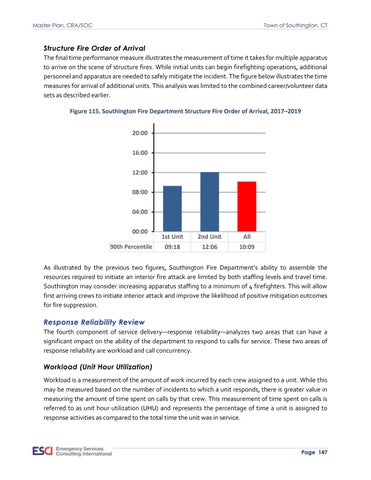Master Plan, CRA/SOC
Town of Southington, CT
Structure Fire Order of Arrival The final time performance measure illustrates the measurement of time it takes for multiple apparatus to arrive on the scene of structure fires. While initial units can begin firefighting operations, additional personnel and apparatus are needed to safely mitigate the incident. The figure below illustrates the time measures for arrival of additional units. This analysis was limited to the combined career/volunteer data sets as described earlier. Figure 115. Southington Fire Department Structure Fire Order of Arrival, 2017–2019 20:00 16:00 12:00 08:00 04:00 00:00 90th Percentile
1st Unit
2nd Unit
All
09:18
12:06
10:09
As illustrated by the previous two figures, Southington Fire Department’s ability to assemble the resources required to initiate an interior fire attack are limited by both staffing levels and travel time. Southington may consider increasing apparatus staffing to a minimum of 4 firefighters. This will allow first arriving crews to initiate interior attack and improve the likelihood of positive mitigation outcomes for fire suppression.
Response Reliability Review The fourth component of service delivery—response reliability—analyzes two areas that can have a significant impact on the ability of the department to respond to calls for service. These two areas of response reliability are workload and call concurrency.
Workload (Unit Hour Utilization) Workload is a measurement of the amount of work incurred by each crew assigned to a unit. While this may be measured based on the number of incidents to which a unit responds, there is greater value in measuring the amount of time spent on calls by that crew. This measurement of time spent on calls is referred to as unit hour utilization (UHU) and represents the percentage of time a unit is assigned to response activities as compared to the total time the unit was in service.
Page 147












